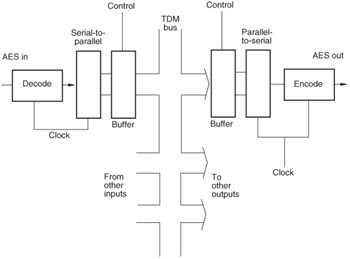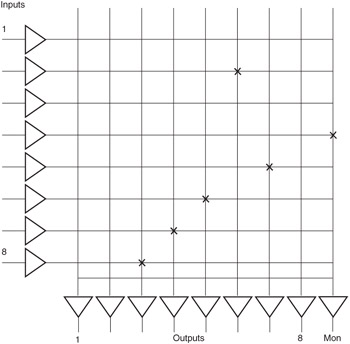6.11 Routers and Switchers
| | ||
| | ||
| | ||
6.11 Routers and Switchers
There are essentially two ways by which standard two-channel interface signals may be routed and switched in systems such as broadcast studio centres where a number of sources and destinations exist. One technique is to use a TDM (Time-Division Multiplexed) switcher, and the other is to use a conventional logic-based crosspoint router. Which is appropriate depends largely on the importance of 'silent' switching, such as might be required for 'hot' or 'on-air' applications, since in a router used simply for assigning signals between sources and destinations (the equivalent to an analog jack-field) it may not matter that discontinuities arise when routing is altered .
In a TDM switcher all the inputs must be synchronous and must be tightly phased inside the router to allow switching at precise timing points within the AES/EBU frame. The inputs are decoded and time-division multiplexed onto a fast parallel bus (as shown in Figure 6.17), allowing output routing to be determined by extracting data in the appropriate channel time slot on the bus and assigning it to a particular output. As suggested by de Jaham 19 , the TDM switcher is appropriate when a large number of sources and destinations are involved because the physical space occupied 'per switching point' is smaller compared with a simple crosspoint router, yet the TDM switcher is complex in design and not usually cost effective for a small to medium number of inputs.

Figure 6.17: In a TDM router, input signals are decoded and multiplexed onto a common high speed bus. Inputs are routed to outputs by extracting data in the appropriate time slot for a particular input channel. Inputs must be synchronous for successful TDM routing.
The crosspoint router may be a simple matrix of inputs and outputs, allowing any input to be routed to any output by selecting the appropriate 'crosspoint' between the two, using switching logic (see Figure 6.18). Furthermore, the signals may remain in the serial modulated form. One of the great advantages of the crosspoint router is that the inputs do not need to be synchronous, and it could even handle signals of different sampling rates. The problem with such a router is that the precise timing of the crosspoint may be difficult to control, so a glitch may result in the output signal at the time of switching. Evans 12 suggests that the typical level of such glitches is around -50 dBu in the analog domain, but this of course depends on the relationship between analog and digital signal levels. Roe 20 indicates that clicks caused by such switching are usually masked by the digital filtering used in D/A convertors to a level up to around 50 dB below peak. A reframer may be used to detect and remove the corrupted sample from the data stream where noise-free switching is required. De Jaham also suggests that it is possible to mark the digital frames which have been corrupted at the switching point so that they may be suitably concealed by equipment further down the signal chain, but points out that the process of marking is covered by patents belonging to TDF (Tldiffusion de France).

Figure 6.18: A simple crosspoint router may be used to connect a certain input channel to a certain output channel by selecting the appropriate crosspoint. Asynchronous signals may be handled here.
| | ||
| | ||
| | ||
EAN: 2147483647
Pages: 120